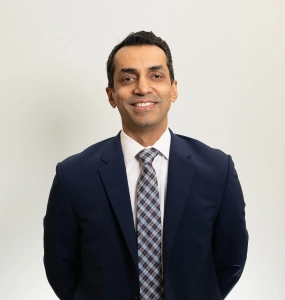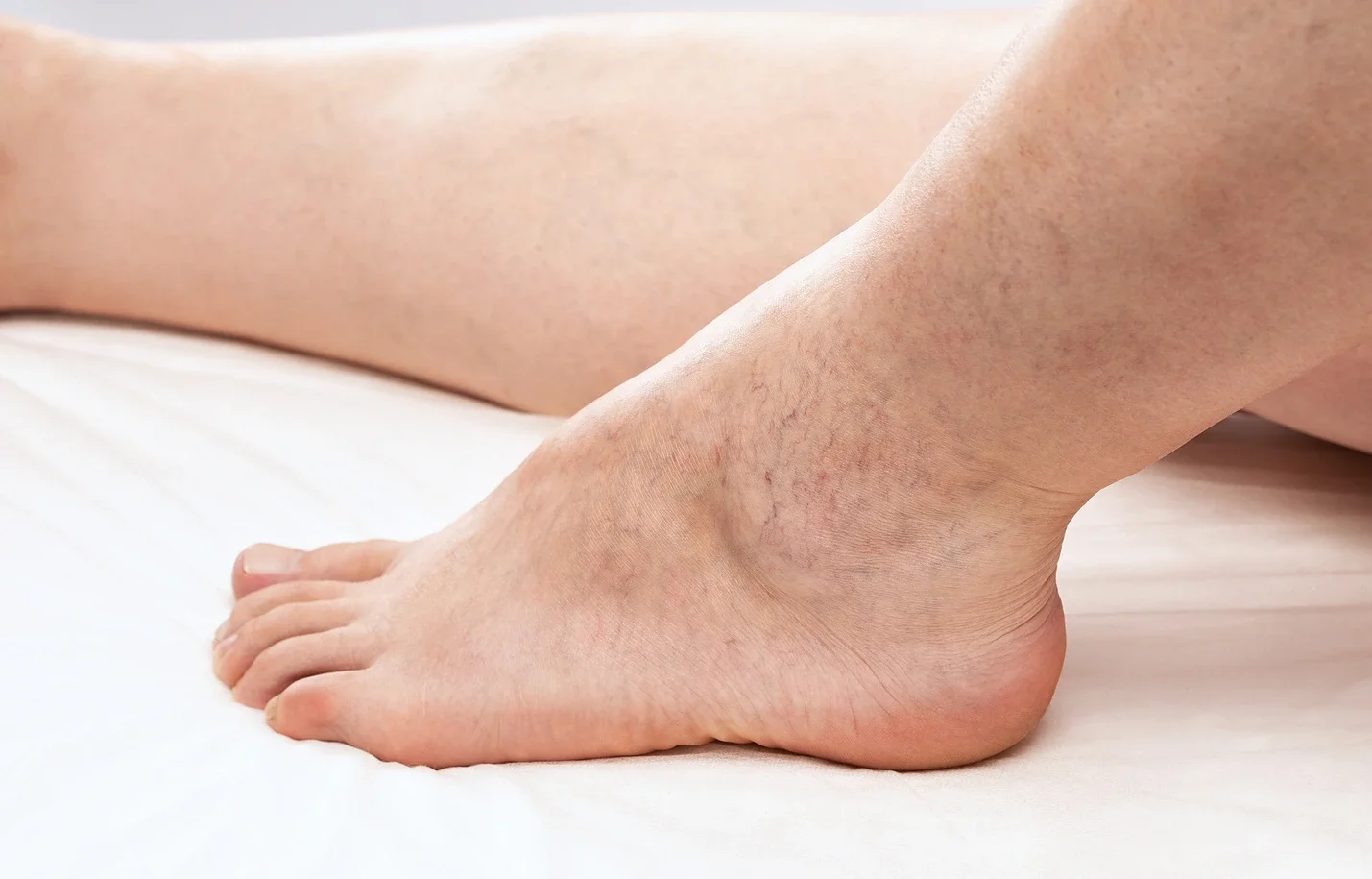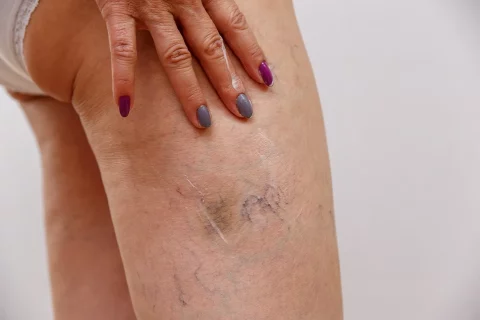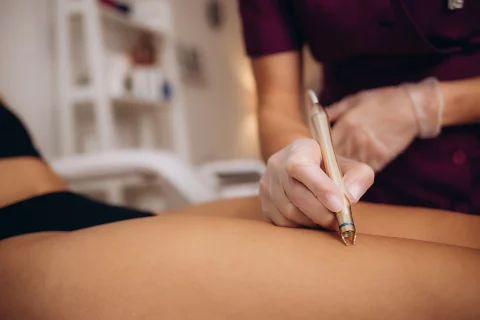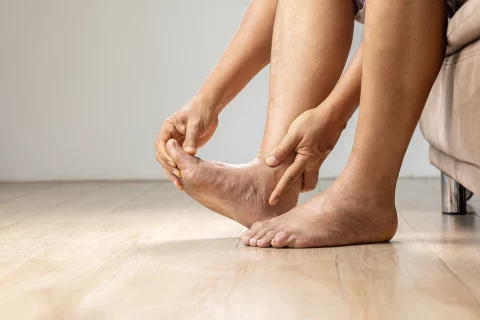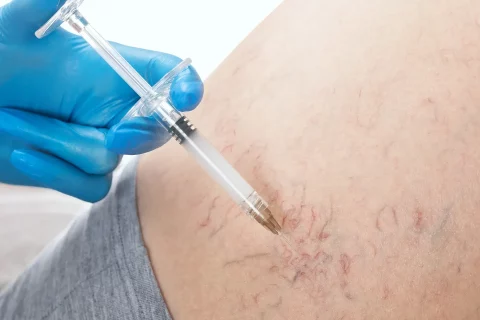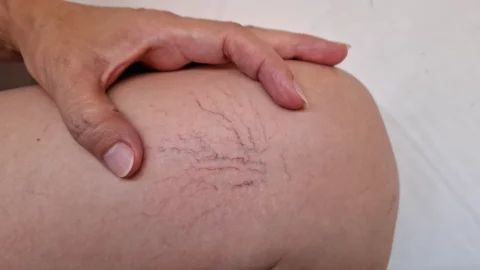Just because spider veins are often harmless, understanding their connection to potential circulatory issues, and ultimately, stroke risk, is crucial.
Spider veins aren’t usually harmful, but they can sometimes signal underlying circulatory problems. These problems can increase your risk of blood clots, potentially leading to stroke, particularly as you age.
Living with unwanted veins is a thing of the past, when you can simply schedule a free consultation with Vein Center Doctor and find your ideal solution today.
What Are Spider Veins?
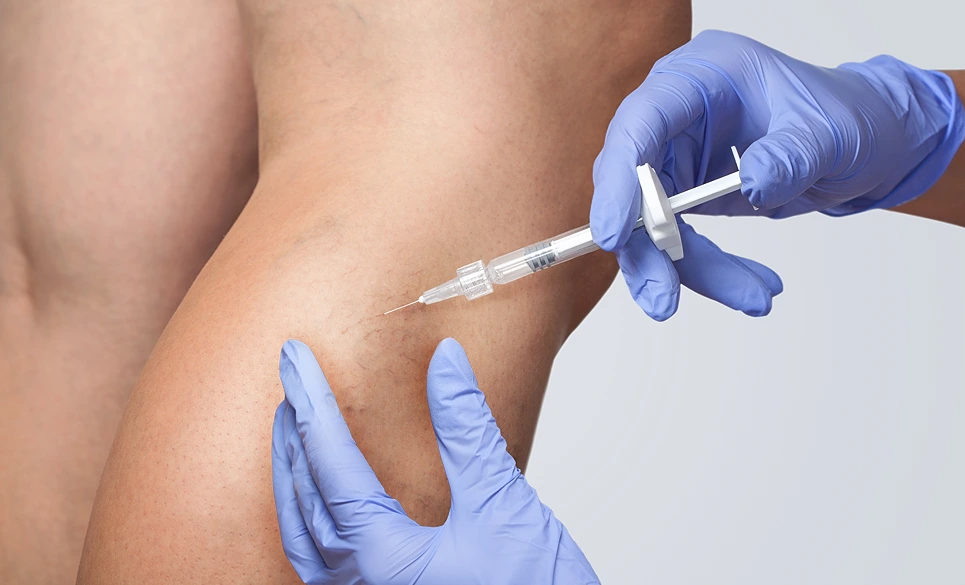
Spider veins are small, damaged veins that appear close to the skin’s surface. They often manifest as red, blue, or purple markings, resembling delicate tree branches or spider webs.
This appearance of spider veins is a key characteristic, and their location on the legs, face, ankles, chest, or abdomen is also a notable feature. You’ll find that they’re generally smaller than varicose veins. While they rarely produce significant symptoms, their aesthetic impact can be considerable.
Several factors contribute to the development of spider veins, collectively referred to as causes spider veins. Weakened or damaged valves within the veins disrupt the proper flow of blood. The increased pressure from factors like body weight, gravity, and the effort of blood returning to the heart all play roles.
Hormonal fluctuations during specific life stages like puberty, pregnancy, breastfeeding, and menopause are also common causes. Consistent standing or sitting, limited exercise, and immobility also contribute to the problem. A family history of spider veins plays a significant role, with up to 90% of individuals experiencing a familial link.
The appearance spider veins can be understood in relation to these causes. Weakened valves allow blood to pool and stagnate, causing the veins to dilate and become visible through the skin. Hormonal changes also trigger shifts in blood flow, further impacting vein visibility.
Factors like prolonged standing put pressure on the veins, leading to stretching and the development of visible patterns. These are key understandings of spider veins and important to note in any study investigating these conditions.
Spider Veins and Stroke Risk
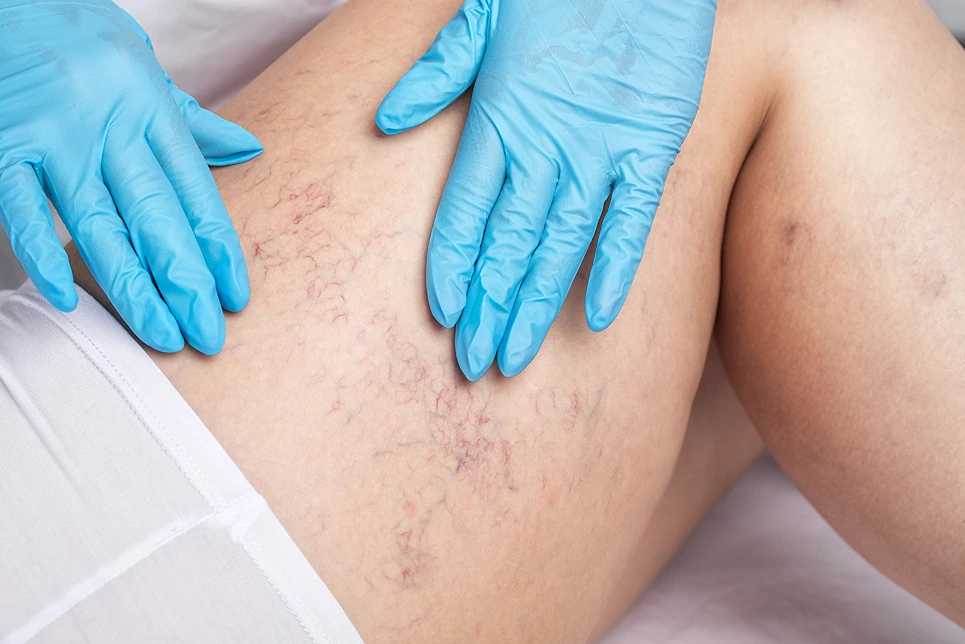
Small, visible veins, often appearing as spiderwebs, mightn’t directly cause strokes, but they can signal underlying venous issues. Venous insufficiency, a condition these veins often indicate, increases your risk of blood clots forming in your legs. These clots can break free and travel to your brain, potentially causing an ischemic stroke. While the risk of stroke from spider veins is relatively low, it highlights the importance of addressing underlying venous health issues.
Weakened vein valves allow blood to pool, increasing clot risk. This clot formation is a key complication of venous insufficiency. Regular checkups are crucial as clots may not always exhibit obvious symptoms.
Factors like age, genetics, and lifestyle choices influence both spider veins and stroke risk. Advanced age weakens vein valves, increasing vascular vulnerability. A family history of venous insufficiency or stroke raises your risk. Prolonged standing or sitting, obesity, and a sedentary lifestyle exacerbate both conditions. Hormonal shifts and UV exposure can also play a role.
Maintaining a healthy weight, avoiding prolonged immobility, and adopting a healthy lifestyle help prevent spider veins and reduce stroke risk. Treatment options for spider veins, like sclerotherapy, can also address underlying venous insufficiency. Early detection and treatment of venous disease significantly decrease the chance of complications, including stroke.
Prioritizing clot prevention is vital for overall health. Addressing venous health issues associated with spider veins is a proactive measure to mitigate your stroke risk.
Diagnosing Spider Veins
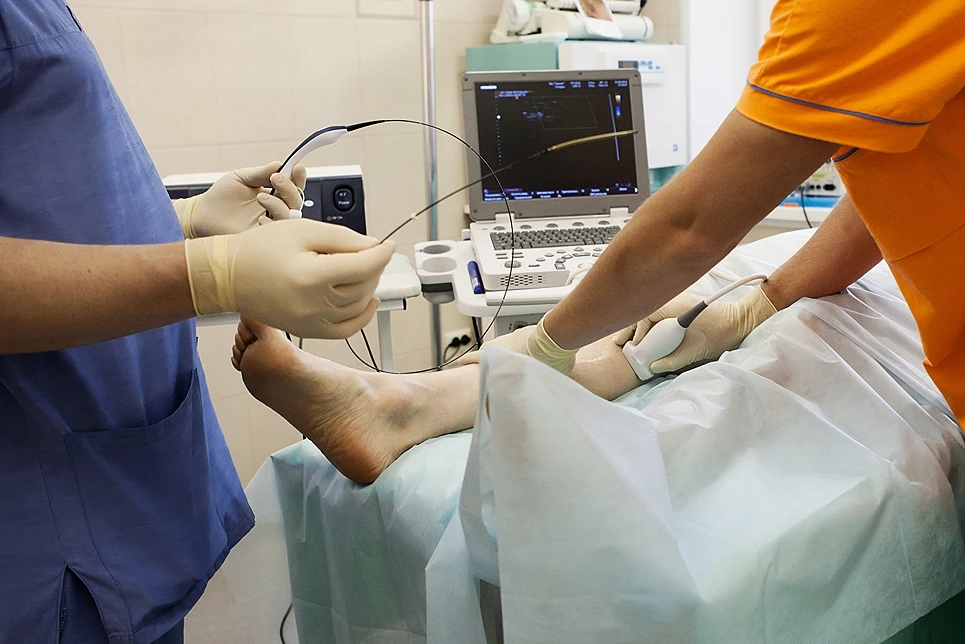
How are visible veins diagnosed? A clinical evaluation is the primary diagnostic method for spider veins.
You’ll be assessed for visible red or bluish-purple blood vessels commonly found on legs, thighs, face, forearms, or hands. A cosmetic appearance is often the first clue, with the presence of varicose veins nearby also noted. While rarely symptomatic, mild discomfort like dull aching or burning sensations might be present.
Diagnostic methods extend beyond visual inspection. Duplex ultrasonography is crucial for venous disease, mapping the venous system, especially if chronic venous insufficiency is suspected. Beyond ultrasound, contrast venography and magnetic resonance venography are alternative diagnostic techniques.
Ultrasound scans precisely trace the origin of varicose and spider veins in the leg. Such high-quality imaging ensures precise treatment planning.
- Ultrasound guidance is key to treating underlying vein issues.
- Specialized tools like the AccuVein Vein Viewing System enhance visibility.
- Experts in vascular sonography produce accurate reports.
To further assess the condition, the CEAP classification system is used (ranging from C0 to C6). Spider veins fall under C1 (telangiectasias and larger reticular veins).
Evaluating valve function and blood flow in your legs is also part of the diagnostic process. Duplex ultrasonography can detect blood clots. Ultimately, understanding the structure of your leg veins is crucial for determining the best course of treatment.
These diagnostic methods, combined with a clinical evaluation, provide a comprehensive approach to diagnosing spider veins.
Treating Spider Veins
Once diagnosed, treating spider veins involves various methods.
Sclerotherapy, a common approach, involves injecting a sclerosing agent into the veins, obliterating them. This procedure, often using agents like polidocanol, offers high patient satisfaction with results appearing in a few weeks to months. Sclerotherapy benefits include general painlessness and minimal downtime. Insurance coverage is sometimes available, especially if underlying vein disease is present.
Laser therapy, another effective treatment, uses focused light beams to target and destroy the veins. Its effectiveness is notable, with immediate results for smaller veins, while larger ones fade over months. However, laser therapy can cause some burning sensations during the procedure, and potential pigmentation changes are possible, especially on the face or legs.
Endovenous ablation, a sophisticated treatment, utilizes heat to close off diseased veins. Radiofrequency (RF) ablation and endovenous laser ablation (EVLT) are examples, each with high success rates. The procedures come with minimal pain and discomfort and are frequently covered by insurance.
Ambulatory phlebectomy, the closure system, hypertonic saline, IPL therapy, and thermocoagulation are also options, although sclerotherapy and laser therapy remain more prevalent.
Knowing available treatment options and their respective sclerotherapy benefits and laser therapy effectiveness is crucial for effective management.
Preventing Spider Vein Complications
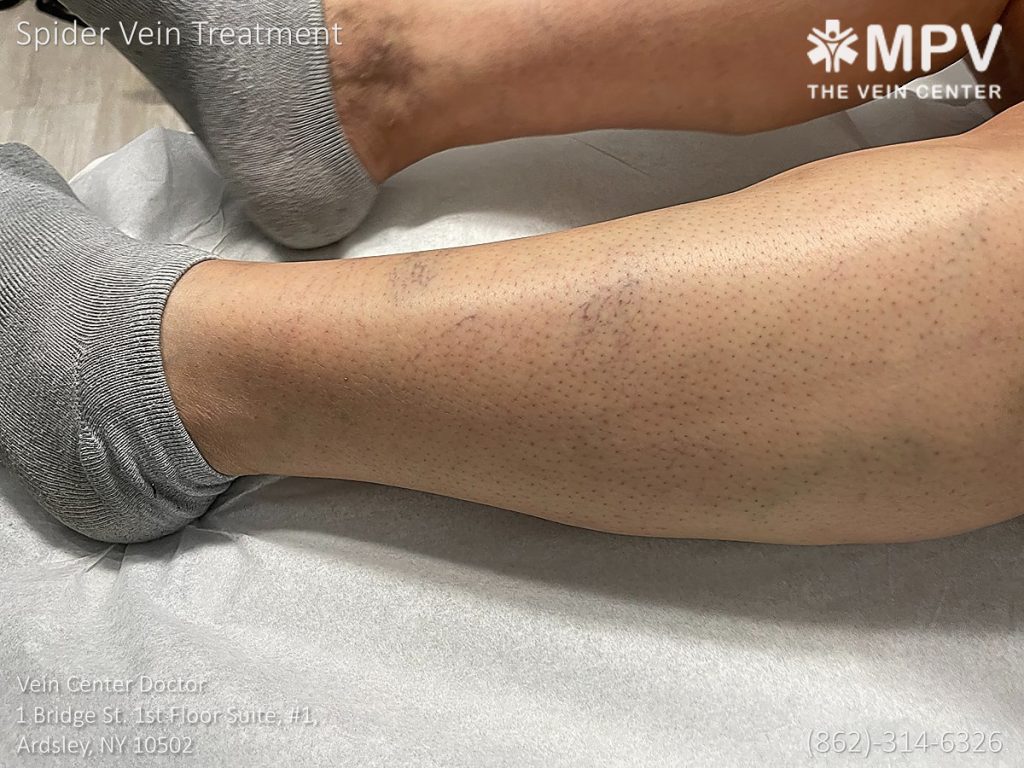
Preventing spider vein complications involves proactive measures concerning lifestyle, environmental factors, and underlying conditions.
Maintaining healthy lifestyle habits is crucial. Regular exercise boosts circulation and strengthens leg veins. Avoid prolonged sitting; move every hour to prevent fluid buildup. Maintain a healthy weight to reduce pressure on veins. Ergonomic adjustments, such as standing desks, are beneficial.
Wearing appropriate clothing and footwear is equally important. Compression socks improve blood flow, and supportive shoes prevent constrictions. Avoid tight clothing and opt for comfortable, supportive shoes. Use compression socks consistently, especially post-treatment.
Managing environmental factors is also key. Elevate legs at night to prevent pooling. Limit exposure to extreme heat. Sunscreen protects facial skin from damaging UV rays, which can contribute to spider veins. Avoid prolonged standing or sitting without breaks. Maintain healthy skin moisture levels, avoiding excessive heat or cold.
Monitoring underlying conditions is vital. Be aware of genetic predispositions and hormonal influences. Manage venous insufficiency and address varicose veins. Watch for signs of chronic venous insufficiency or related skin conditions. Quit smoking to improve vascular health. Be mindful of systemic conditions like rheumatoid arthritis or liver disease, which can sometimes manifest as spider angiomas.
- Exercise regularly for better circulation and vein strength.
- Elevate your legs before bed to prevent fluid buildup.
- Manage underlying conditions proactively to reduce spider vein risk.
Dr. Sood at Vein Center Doctor is always happy to offer free consultations to anyone looking to understand their vein issues. Don’t spend another day wondering how to make those visible veins go away. Call us at 862-227-1143 today!
